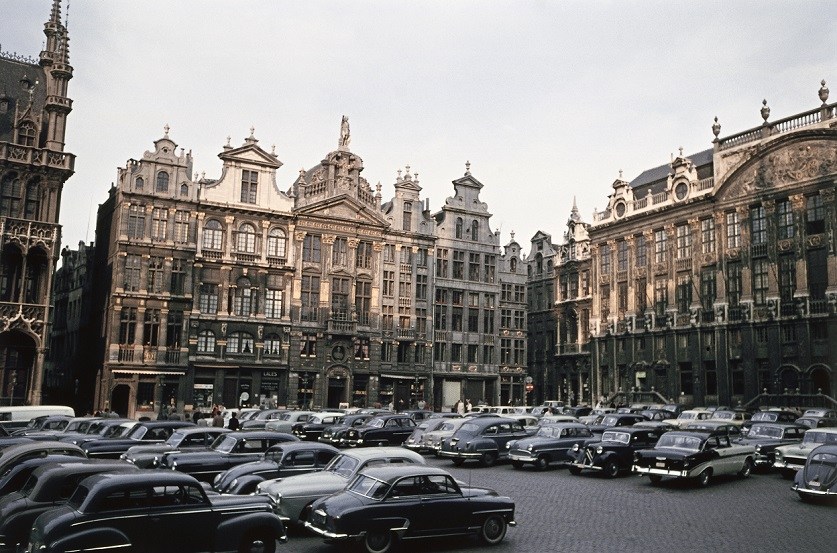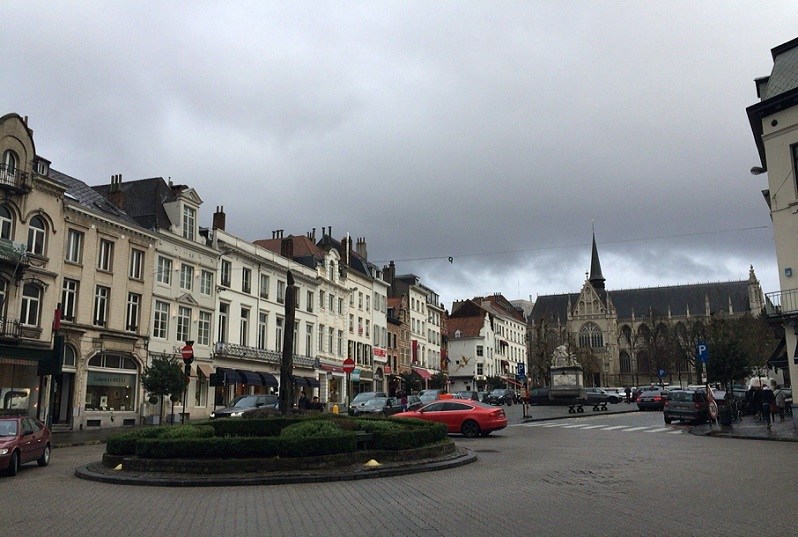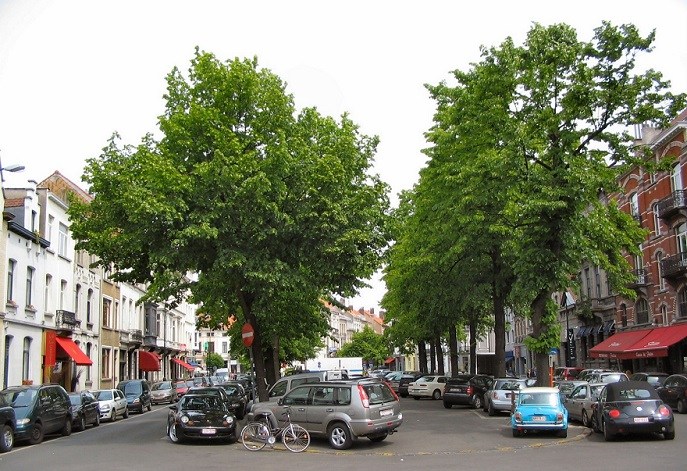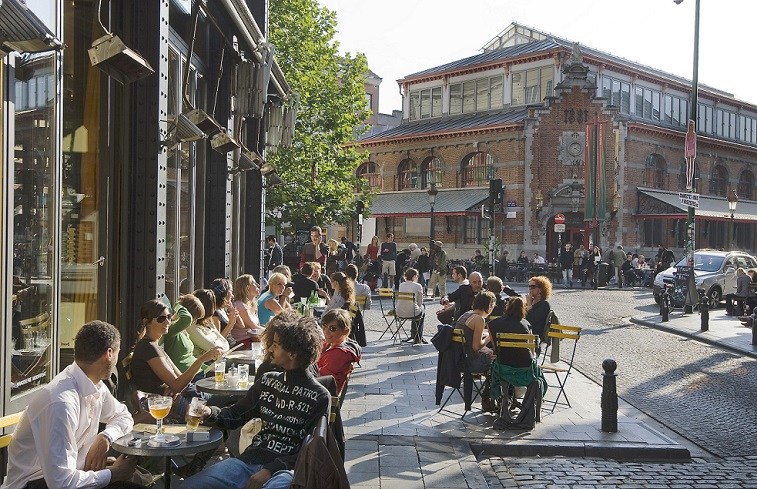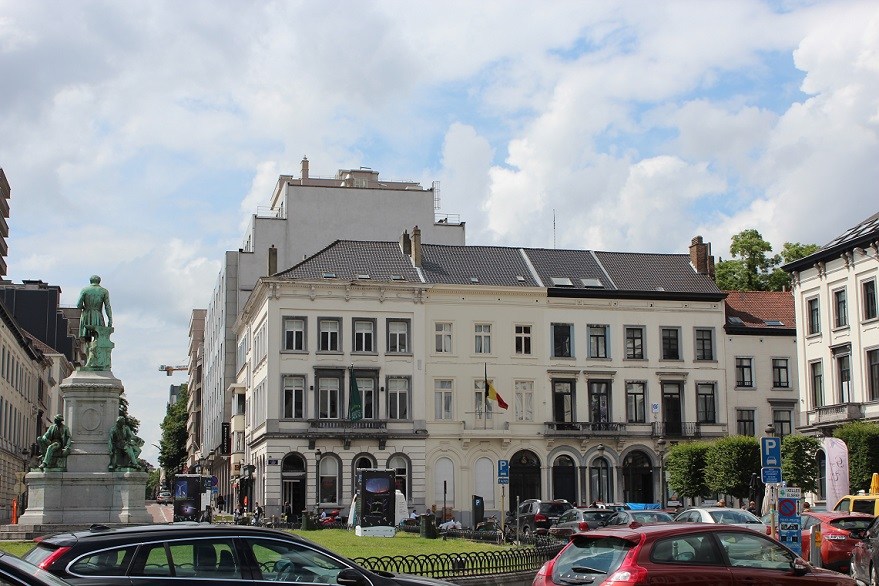Brussels has some of the most beautiful squares in the world. Unfortunately, most are either glorified roundabouts or glamorous car parks. If the Belgian capital really is to become a city for people, not cars – as most voters, planners and politicians agree it should be – it is time to start removing the vehicles and pedestrianising our priceless public spaces.
Squares are the beating hearts of European cities. From Red Square in Moscow to the Place de la Bastille in Paris, they are places where history is made, celebrations are held and commerce thrives. But most importantly, they are urban oases where locals and tourists gather to meet, mingle and marvel. “Public squares are places where people come together to relax, play, flirt, read a book, have a coffee and feel good in the city,” says Pascal Smet, the Brussels minister for urban planning. “They are places of interaction and wonderment where city life becomes less aggressive and where people trust each other more. You cannot do that with cars.”
Unfortunately, Brussels is a city that has been in thrall to cars ever since they replaced horses and carts. Until the early 1990s, it was possible to drive through the medieval streets in Brussels’ city centre and park your car in the middle of the Grand Place – the UNESCO World Heritage site that Victor Hugo described as “the most beautiful square in the world.” And it is still a city where squares have become traffic islands, where cars whizz through parks and forests, and where you can park your vehicle below the national monument or in front of the royal palace.
In recent years, huge progress has been made in curbing the rampant car use that has made Brussels one of Europe’s most congested and polluted cities. Major roads have been pedestrianised, cycle lanes created and some squares revamped. But there is still a long way to go before the city’s squares are handed back to the people they were designed for.
Everyone has their shopping list of squares they would like to see wrestled from the grip of the car. Here are 10 Brussels squares that are ripe for renewal.
Place du Grand Sablon
This swanky, sloping square, surrounded by upmarket eateries, chocolate shops and antique dealers, and topped by a gorgeous Gothic church, rivals the Grand Place in beauty. Unfortunately, today the cobbled square is little more than a posh parking lot surrounded on all sides by busy streets.
In recent elections, Smet campaigned to have cars banned from parking on the square. But he faces staunch opposition from some local shopkeepers and restauranteurs. “Smet poses as a Julius Caesar who can just decide about the death or life of businesses,” an antique store owner told the RTBF TV channel, adding “we cannot survive without parking.”
Given the success of Green and Socialist parties in recent local and regional elections in Brussels – and the public clamour for action to tackle air pollution and climate change – it is highly likely that cars will be removed from Place Sablon in the coming years. But for the moment, it is scarred by an act of urban vandalism that disfigures what should be one of Europe’s most elegant squares.
Place Sainte Catherine
The façade of the Sainte Catherine church has been cleaned and the small square is ringed by charming restaurants – including the massively popular fish joint Nordzee -but cars can still drive around three sides of Place Sainte Catherine. Contrast this with the Vieux Marché aux Grains across the street – a delightful, pedestrianised square with plane trees and outdoor terraces providing a perfect spot to have a sip and a stroll on summer evenings. Banning cars from Sainte Catherine and Rue de Flandre – one of Brussels’ best streets for eating and drinking – would create a bustling foodie haven far superior to the tourist traps around the Grand Place.
Place du Châtelain
On Wednesday evenings, this leafy small square in Ixelles is shut off to cars so well-heeled EU types can buy over-priced delicacies at the weekly market or sup Spritzes in one of the many bars that spill onto the Place. But for the rest of the week, the square is a parking lot, depriving locals of a pretty public space in a dense urban area.
Place Saint Géry
Some of the side streets may have been pedestrianised, but it is inexplicable why St. Géry, a beautiful central square surrounded by bars, should welcome drivers. In a city renowned for its love of food, the graceful old meat market in the centre of the square should be converted into a food hall to rival Rotterdam’s Markthal. And the square should be shut off to traffic so revellers in iconic bars like Zebra and Roi des Belges don’t have to stare at each other over a street only used by show-offs.
Place Sainte Gudule
In most cities, churches and cathedrals are given the respect places of worship deserve. In Brussels, they act as roundabouts for traffic. The Cathédrale des Saints Michel et Gudule is no different. “It is completely nuts that you have cars driving round the cathedral,” says Smet, adding that local authorities are working on plans to curb cars around Brussels’ imposing but underwhelming cathedral.
Place Saint Boniface
Work is almost finished pedestrianising Chausée d’Ixelles, a once traffic-clogged shopping street in Ixelles. And in front of the town hall, Place Ferdinand Cocq has been transformed beyond recognition by restricting car access and adding more greenery. But cars are still allowed to crawl around the small but magnificent Place St. Boniface. Overlooked by the turreted spires of the church of St. Boniface and surrounded by classy restaurants and bars, this elegant square could be one of Brussels’ finest public spaces if cars were blocked.
Place de la Vieille Halle aux Blés
Brussels is dotted with squares that have been transformed into roundabouts – for example Place Meiser in Schaerbeek and Place Stephanie in Ixelles. The smallest, and most handsome of these is Place de la Vieille Halle aux Blés, just up the street from the Manneken Pis statue. A Jacques Brel museum and a handful of under-visited cafes and restaurants ring the square, which has a forlorn statue on a traffic island as its centrepiece. As the Belgian surrealist artist René Magritte would have quipped: “Ceci n’est pas une place.”
Place van Meenen
Parvis Saint Gilles shows what a difference completely pedestrianising a square can make. You won’t find many tourists here, but this lively square in the heart of the cosmopolitan St Gilles neighbourhood is a model for what urban spaces should be. And it is set to get even better when the scruffy Place Marie Janson it flanks is transformed into a city park.
Contrast this with Place van Meenen, the square outside St Gilles’ faux-Gothic town hall. Apart from Mondays, when a food market is held, this handsome square is a car park for council officials. Hardly the best advert for sustainable living in a council now co-run by Greens
Place Luxembourg
The EU neighbourhood of Brussels is dominated by noisy thoroughfares and ugly, boring buildings. Place Luxembourg is one of the few exceptions. A graceful square of four-story townhouses overlooked by the European Parliament, this should be a pedestrianised meeting space for all Europeans. Instead, it is a busy roundabout that is only to shut to traffic on Thursday nights – when young Eurocrats flock to ‘PLux’ to get plastered.
Place de la Liberté
A delightful, tree-lined square tucked away behind the Belgian parliament, Place de le Liberté could easily be pedestrianised – at least on three sides - allowing popular bars like Café Caberdouche to extend their terraces on summer evenings.
There are many other squares in Brussels that are in need of a radical overhaul – for example Parvis Saint Pierre and Place Saint Job in Uccle, Place Brugman in Ixelles and Place de la Beguinage in the city centre.
There are also others that have been reworked but are distinctly underwhelming. Molenbeek’s Parvis Saint Jean is supposed to be car-free but the local council chooses to ignore vehicles parked on the square. Place Flagey remains somewhat soulless after its giant, shady trees were cut down to create a car park beneath. And Place de Brouckère in the centre is proof that semi-pedestrianising a square is as impossible as being semi-pregnant. Windswept and flanked on two sides by busy streets and on one side by monstrously ugly office blocks, the newly-minted square is better than it used to be but not a place where you’d want to hang out.
“Things are getting better,” argues Smet in a downtown café. Despite the occasional hiccup, it is hard to disagree with the former Brussels transport minister, who pushed through plans to pedestrianise large chunks of the city centre in the teeth of fierce opposition from local shopkeepers.
Boulevard Anspach, a busy thoroughfare running through the heart of the old town until two years ago, has been turned into a car-free walkway with benches, trees and lawns. In front of the old stock exchange on Place de la Bourse, finishing touches are being put to a brand new square with fountains. Cars have been removed from the recently renovated Place Jourdan in Etterbeek – although cyclists complain they have been squeezed - and Place du Miroir in Jette has been completely transformed.
And there are plenty of improvements in the pipeline. Plans have been approved for a bold redesign of Place Schuman in the centre of the EU area and there are ambitious proposals to turn the giant car park between Place Louise and Porte de Namur into a sculpted park with extended bike lanes and walkways.
“The people of Brussels have changed,” says Smet. There is a feeling that there are too many cars, and we need more public space and more greenery. My dream is that in 10-15 years, the area inside the inner ring will be car-free.”
Listening to Smet, one is reminded of the lyrics of [Nothing But] Flowers, a satirical song by Talking Heads about nature taking over cities from cars: “Once there were parking lots/Now it’s a peaceful oasis.” The difference is, this is no longer a dream. In the centre of Brussels, it is fast becoming a reality.
By Gareth Harding

